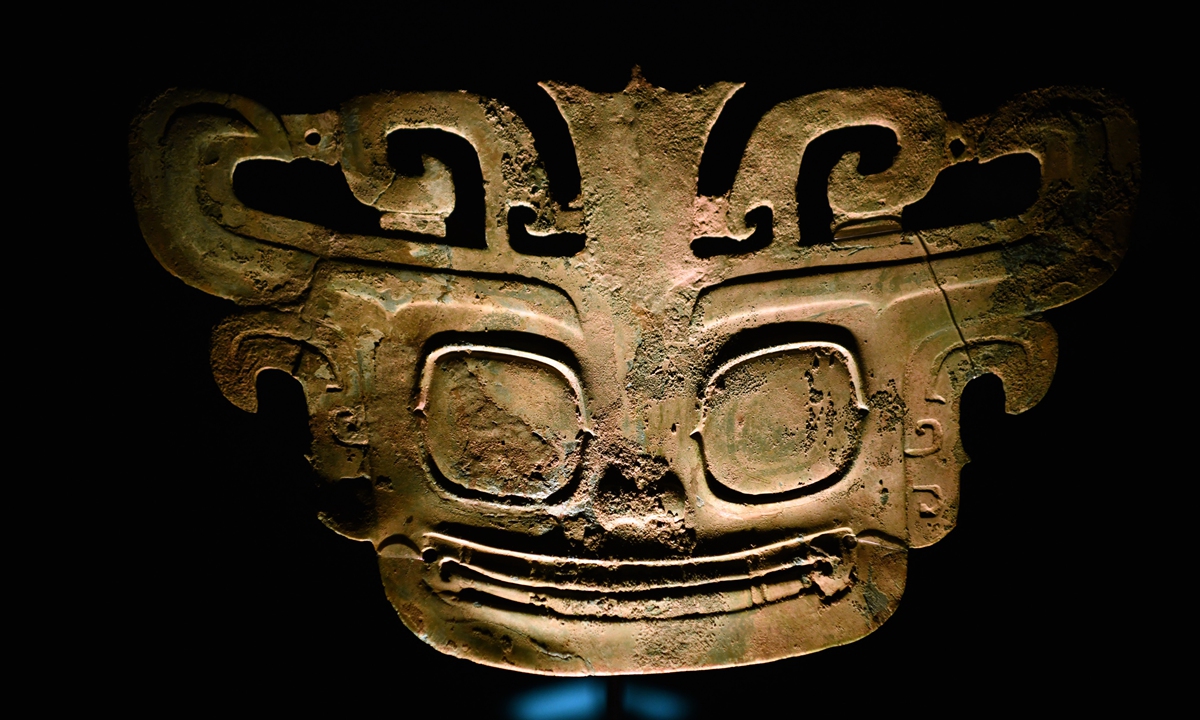
Cultural relics from Sanxingdui Ruins Photo: IC
Nearly 13,000 cultural relics have been unearthed from six pits of the Sanxingdui Ruins site, including many wares and statues never seen before, and they help present a more complete and abundant view of the culture of the ancient Shu kingdom, according to a press conference to discuss the achievements of a new round of archeological excavation on Monday.
The excavation mainly aimed at the sacrificial area of the ruins and six newly discovered pits. From 2020 to 2022, a total excavation area of 1,834 square meters was explored in the sacrificial area, which was roughly a rectangular distribution area from northwest to southeast, and it covered a total area of nearly 13,000 square meters, as reported at the press conference.
The significant discoveries in the excavation include thousands of cultural relics made of different materials such as bronze, gold and jade and unearthed in six new pits, ruins of architecture, time of building the pits and the proof of exchanges between the ancient Shu kingdom and the Central Plains in the Shang Dynasty (c.1600BC-1046BC).
Among the cultural relics newly unearthed, archeologists found 3,155 relatively intact relics, including more than 2,000 bronze wares and statues.
"All cultural relics have significant meanings for archeological research. If I have to choose one, I want to select the crowned bronze statue with a snake's body," Ran Honglin, director of the Sanxingdui cultural relics and archeology research institute, told the Global Times on Monday.
The bronze statue has three parts. An image of a man with the specific characteristics of the Shu kingdom and a snake's body is in the middle, which props both hands up on a bronze lei with a square pedestal. It has a vermillion painted zun (lei and zun were names of bronze drinking vessels) on the head.
Ran noted that the relics prove the diversity of Chinese culture and offer another powerful example of Chinese civilization's unity in diversity because of its shape melting cultural factors of different areas in China during ancient times. The zun was rare in the Shu kingdom and only popular in the Central Plains.
Archeologists also found special items like a grid-like ware with a turtle-back shape made of bronze and jade. Researchers said that such items have not been found previously. It comes with four bronze dragon head handles and two or three bronze ribbons, and the most amazing thing is that there is a piece of turquoise jade embedded.
A bronze altar that is nearly one meter tall reflects a sacrificial scene, which is the immortal world imagined by the ancient Shu people. The altar is also composed of three parts from low to high, and the bottom part is a platform with hollow patterns. In the center of each platform, there is a person sitting in the center and seems very muscular
The cultural relics such as a giant bronze mask, a kneeling figure with its head turned and jade knives enrich the category of the Sanxingdui site's relics. The research shows that the bronze casting technology of the Sanxingdui site was a combination of mold casting and split casting, using riveting, core bones and other technologies.
Archeologists extracted the fibroin from the bodies of some cultural relics such as ivory and bronze wares in several pits. The discovery proves that there was silk in the ancient Shu kingdom and fills in a blank in the history of silk in the Xia Dynasty (c.2070 BC-c.1600 BC) to the Shang Dynasty in Southwest China.
Researchers used Carbon-14 dating to confirm that nearly 200 samples unearthed in different pits were made from 1131 BC to 1012 BC, so they concluded that in addition to the fifth and sixth pits appearing later, the rest of the pits should have been built in the late Shang dynasty, dating from 3,000 to 3,200 years ago. The discovery has resolved a controversy over the age of sacrificial pits found in the past three decades.
At the press conference, researchers also explained the protection work of unearthed cultural relics. During the conservation and cleaning process, the researchers used many high technologies.
Using microscopic observations, they found many remnants of silk and traces of jade production and use. They also made a preliminary analysis of the structure, composition and casting process of some typical bronze and jade wares by means of micro CT, scanning electron microscopes and Raman spectroscopy.
The excavation and research work at the Sanxingdui Ruin site is continuing and the field excavation is expected to be completed in October.
"The number of unearthed cultural relics will keep increasing with further work," Ran noted.




